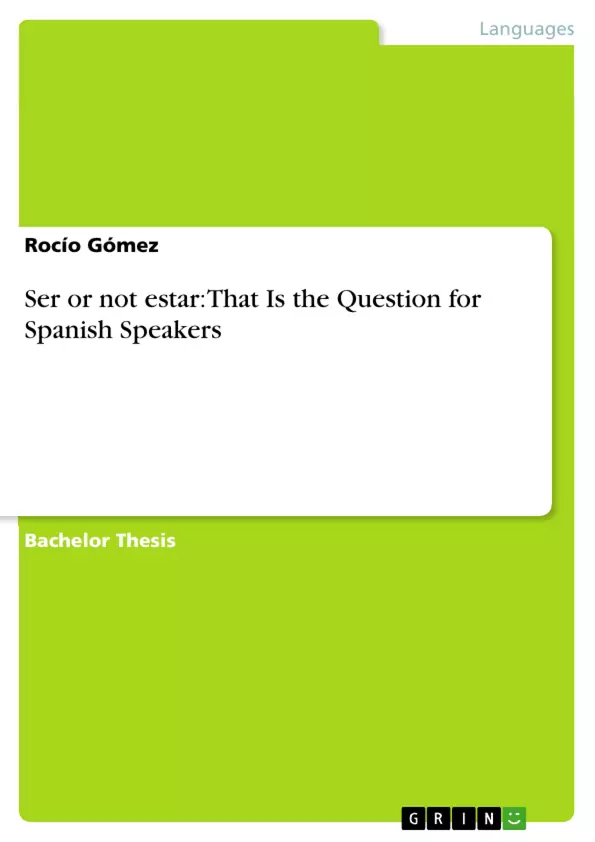The purpose of this thesis is to discover whether the dichotomy of Ser/Estar in Spanish, in contrast with the verb To Be in English, represents not only a different view of the world of their speakers, but also a difficulty in the translation of said verbs. In order to find an answer, this work was divided in different sections for a more comprehensive analysis of all its variables.
First of all, a section regarding the history of the copulas and the languages in question was provided, in order to identify their origins, development throughout time, among other factors. The aim of this analysis was to discover why both languages differed in their copulas, given that it would seem English speakers never found themselves in the need to make a distinction so obvious in Spanish. The following step was an overview of the philosophical value of ser, as explained by many well-known thinkers of all periods. The purpose of the overview was to further comprehend a very important difference between ser and estar, as well as to compare them with their English equivalent. Another subject studied in this section was the importance of language in the construction of reality. This was also important due to the fact that, throughout history, the views regarding the world, the society and people themselves have changed progressively; and said evolution, in turn, affected and was affected by the language.
After setting forth these baselines, texts from different periods, both in English and Spanish were analyzed. This served to examine the evolution of the uses and spelling of the three verbs during the different times in history, and corroborate and expand the results found in the first stage of this work. Within this section there was also an analysis of difficult cases regarding the translation of these verbs, taking different popular examples, among which was the famous soliloquy To be or not to be. The results obtained provided a framework to find methods to facilitate the translation of ser, estar and to be, both from Spanish into English –which was particularly problematic- and vice versa.
It was concluded that even if there were not two separate words in English to represent both Spanish copulas, the language had evolved to provide different resources to make the differences clearer; resources which could be of much use in the translation of problematic cases.
Inhaltsverzeichnis (Table of Contents)
- INTRODUCTION
- 1.A Ser/estar Dichotomy
- 1.B The Effect of Language on the Life of Men
- 1.C The Philosophic Value of the Being..
- 1.D The Translation of the Verbs in Question
- 1.E Hypothesis and Objectives
- SER, ESTAR AND TO BE IN CONTEXT..
- 2.A Initial considerations
- 2.B Etymologies.........
- 2.C Brief Overview of the Beginning and Development of the Spanish Language..
- 2.D Brief Overview of the Beginning and Development of the English Language....
- 2.E The Being as a Philosophical Concept..
- 2.F The Role of Language in the Construction of Reality.
- THE LITERARY IMPRINTS OF THE COPULATIVE VERBS.
- 3.A Evolution of the Verbs Ser, Estar and To Be.
- 3.A.a To Be..
- 3.A.b Ser and Estar.
- 3.B The translation of the verbs ser, estar and to be.
- CONCLUSION...
Zielsetzung und Themenschwerpunkte (Objectives and Key Themes)
This work aims to investigate the linguistic and philosophical implications of the ser/estar dichotomy in Spanish, examining its historical development, its impact on the perception of reality by speakers of both English and Spanish, and its influence on literary expressions.
- Historical and linguistic evolution of the verbs ser, estar and to be.
- The influence of language on the construction of reality and individual identity.
- The role of the ser/estar dichotomy in shaping the worldviews of English and Spanish speakers.
- The literary expressions and interpretations of the verbs ser, estar and to be in various literary works.
- The philosophical implications of the concept of "being" in different languages and cultures.
Zusammenfassung der Kapitel (Chapter Summaries)
- INTRODUCTION: This chapter introduces the central question motivating the research: why does Spanish utilize two distinct verbs, "ser" and "estar," to express what seemingly amounts to the same concept in other languages, including English? The chapter also outlines the methodology and objectives of the research, emphasizing the historical, linguistic, and philosophical aspects that will be explored.
- SER, ESTAR AND TO BE IN CONTEXT: This section delves into the historical and linguistic contexts of the verbs "ser," "estar," and "to be." It investigates the etymological origins of these verbs, tracing their development from ancient Indo-European roots to their present-day forms in Spanish and English. The chapter also explores the evolution of the Spanish and English languages themselves, highlighting key milestones that shaped their development and the role of language in constructing reality.
- THE LITERARY IMPRINTS OF THE COPULATIVE VERBS: This chapter examines the evolution and use of the verbs "ser," "estar," and "to be" in literary works across different historical periods. It analyzes how these verbs have been utilized in classic texts of both Spanish and English literature to convey various nuances of meaning, identity, and the human experience.
Schlüsselwörter (Keywords)
This research delves into the complexities of language and reality, focusing on the copulative verbs "ser," "estar," and "to be" in Spanish and English. It investigates their historical development, linguistic functions, and philosophical implications, exploring themes of linguistic relativity, cultural identity, and the social construction of reality.
- Quote paper
- Rocío Gómez (Author), 2014, Ser or not estar: That Is the Question for Spanish Speakers, Munich, GRIN Verlag, https://www.grin.com/document/288775



